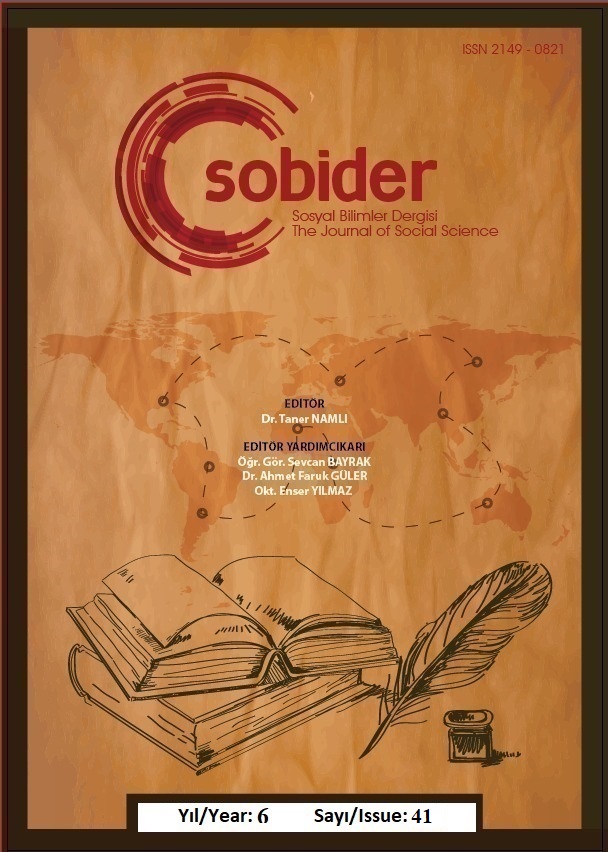Author :
Abstract
Bayburt, Doğu Karadeniz Bölümünün iç kısmında ve Çoruh Nehri’nin yukarı Havzasında yer almaktadır. Bayburt’ta tarih öncesi çağların hemen hemen tümünde iskânla karşılaşılır. Yukarı Çoruh Havzası’nda, özellikle Paleolitik ve Epipaleolitik Çağ araştırmaları neredeyse hiç yapılmamıştır. Buda bölge için büyük bir eksikliğe ve bunun yanı sıra bölgenin tarihi ve arkeolojisi hakkında yapılan değerlendirmelerin bilinçsiz ve yanlış yapılmasına neden olmuştur. Havzanın insan yerleşimine son derece elverişli olması ve özellikle Kalkolitik Çağın sonu ve Tunç Çağının başlarından itibaren yoğun yerleşme görmesi, Paleolitik Çağdan itibaren yerleşme görme olasılığını daha da kuvvetlendirmektedir. Havzanın yukarı kısmında, Çoruh Nehri’nin kollarından Gez Deresi vadisinde, Alt ve Orta Paleolitik Çağa ait konaklama yerine ve bazı aletlere rastlanırken, yine bu bölgede, Bayburt ilinin 5 km. kadar kuzeydoğusunda bir mağarada Epipaleolitik Çağa tarihlenen mikrolitlere ve işlenmiş taşlara rastlanması, bilinenlerin aksine, bölgenin en eski çağlardan itibaren iskân gördüğünü teyit etmektedir.
Keywords
Abstract
Bayburt is located in the interior parts of the Eastern Black Sea Region and the upper Çoruh Basin. The province of Bayburt hosted settlements in almost all prehistoric periods. There are very few researches on the Upper Coruh Basin in the Paleolithic and Epipaleolithic Ages, in particular, which, in turn, to the disadvantage of the region, resulted in unconscious and misleading evaluations on its history and archaeology. The convenience of the basin for human settlement and, in particular, an intensive degree of settlement from the late Chalcolithic and early Bronze Age onwards strengthen the possibility that it witnessed settlements from the Paleolithic Age onwards. The presence of a Lower and Middle Paleolithic camp and some tools in the valley of Gez stream -one of the tributaries of Coruh River- located in the upper part of the basin, along with the microliths and artifacts dated to the Epipaleolithic Age found in a cave located approximately 5 kilometers to the northeast of Bayburt confirm that, contrary to the presumptions, the region has been a place of human settlement from the earliest prehistoric periods onwards.
Keywords
- Akurgal E, (1995), Anadolu Uygarlıkları, İzmir.
- Arınç K, (2004), Türkiye’nin Coğrafi Bölgeleri, (Kıyı Bölgeleri) I. Cilt Erzurum.
- Atalay İ, (1992), Türkiye Coğrafyası, İzmir.
- Atalay İ- Tetik M-Yılmaz Ö, (1985), Kuzeydoğu Anadolu’nun Ekosistemleri, Ormancılık Araştırmaları Enstitüsü Yayınları Teknik Bülten Seri No: 141, Ankara.
- Bingöl A, (2003), En Eski Çağlardan Urartu’nun Yıkılışına Kadar Kars ve Çevresi, Atatürk Üniversitesi Sosyal Bilimler Enstitüsü, Erzurum.
- Dinçol A.M, (1982), "Hititler Öncesinde Anadolu”, Anadolu Uygarlıkları Ansiklopedisi I, 18- 120.
- Erguvanlı K, (1946), “Gaziantep-Narlı Arasında Bulunan Paleolitik Aletler Hakkında Bir Not”, Belleten X/39, 375-380.
- Erinç S, (1953), Doğu Anadolu Coğrafyası, İstanbul.
- Erzen A, (1992), Doğu Anadolu ve Urartular, Ankara.
- Goetze A, (1957), Kulturgeschichte Kleinasiens, München,
- Gündüzalp N, (1986), “İçdoğu Karadeniz Bölgesinden Prehistorik Buluntular”, TTKong. 9, Ankara, 49-54.
- Harmankaya S - Tanındı O, (1996), Türkiye Arkeolojik Yerleşmeleri 1, Paleolitik/ Epipaleolitik, İstanbul.
- Harmankaya S - Tanındı O, (1996), “Baladız/Baradız”, Türkiye Arkeolojik Yerleşmeleri I, Paleolitik/ Epipaleolitik, İstanbul.
- Harmankaya S - Tanındı O, (1996), “Belbaşı”, Türkiye Arkeolojik Yerleşmeleri I, Paleolitik/
- Harmankaya S - Tanındı O, (1996), “Gez Alanı”, Türkiye Arkeolojik Yerleşmeleri I, Paleolitik/ Epipaleolitik, İstanbul.
- Harmankaya S - Tanındı O, (1996), “Killiğin Mağarası”, Türkiye Arkeolojik Yerleşmeleri I, Paleolitik/ Epipaleolitik, İstanbul.
- Harmankaya S - Tanındı O, (1996), “Tekeköy/Fındıcak”, Türkiye Arkeolojik Yerleşmeleri I,
- İzbırak İ, (1984), Türkiye, İstanbul.
- Kınal F, (1991), Eski Anadolu Tarihi, Ankara.
- Kökten İ. K, (1947a), “Bazı Prehistorik İstasyonlar Hakkında Yeni Gözlemler”, DTCFD 5/1-5, 223-236.
- Kökten İ. K, (1947b), “1945 Yılında Türk Tarih Kurumu Adına Yapılan Tarih Öncesi Araştırmaları”, Belleten 11/43, 431-472.
- Kökten İ. K, (1953), “1952 Yılında Yaptığım Tarih Öncesi Araştırmaları Hakkında”, DTCFD 11/2-4, 177-211.
- Kökten İ. K, (1955), “Antalya’da Karain Mağarasında Yapılan Prehistorya Araştırmalarına Toplu Bir Bakış”, Belleten 19/75, 271-283.
- Kökten İ. K, (1975), “Kars ve Çevresinde Dip Tarih Araştırmaları Yazılıkaya Resimleri”, Atatürk Konferansları V, Ankara, 95-104.
- Köse A, (1991), İspir ve Çevresinin Bölgesel Coğrafya Etüdü, Atatürk Üniversitesi Sosyal Bilimler Enstitüsü, Erzurum.
- Özey R, (1994), “Bayburt ve çevresinin Coğrafi Özelliklerine Bir Bakış”, Türk Tarihinde ve Kültüründe Bayburt Sempozyumu (23–25 Mayıs 1988), Ankara, 437–487.
- Özsait M, (1979), “Burdur Çevresinde Yeni Prehistorik Yerleşmeler”, TT Kong 8, Ankara, 101- 106,
- Sever R, (2005), Çoruh Havzası Enerji Yatırım Projeleri ve Çevresel Etkileri, Konya.
- Sevin V, (2003), Anadolu Arkeolojisi, İstanbul.
- Şenel A, (1991), İlkel Topluluktan Uygar Topluma Geçiş Aşamasında Ekonomik, Toplumsal ve Düşünsel Yapıların Etkileşimi, Ankara.
- Tarkan M.T, (1971), Yukarı Kelkit ve Çoruh Havzası, Erzurum.
- Tarkan M.T, (1973), Orta ve Aşağı Çoruh Havzası, Ankara.
- Tarkan M.T, (1974), “Bayburt’un Ekonomik Olanakları ile Bu Olanakların Kalkınma Alanındaki Önem Dereceleri” Edebiyat Fakültesi Araştırma Dergisi, Sayı 5 Ekim 1972, Erzurum, 83–88.
- Ünsal V, (2008), “North-East Anatolia in the Third Thousand Bc”, The Journal Of Internatıonal Social Research Volume: 1, Issue: 3, Spring 2008, 396-410.
- Yalçınkaya İ, (1989), Alt ve Orta Paleolitik Yontmataş Endüstrileri Biçimsel Tipolojisi ve Karain Mağarası, Ankara.
- Yazıcı H, (1995), “Şehir Coğrafyası Açısından Bir İnceleme: Bayburt”, Türk Coğrafya Dergisi 30, İstanbul, 189–218.
- Figür 5. Gez Alanı Buluntuları (Gündüzalp 1986)
- Figür 8. Killiğin Mağarası Buluntuları (Gündüzalp 1986)





